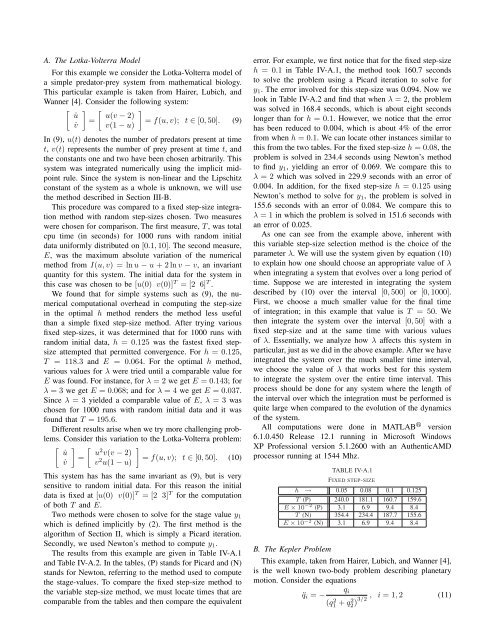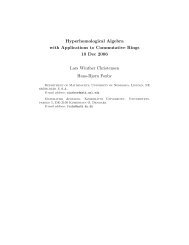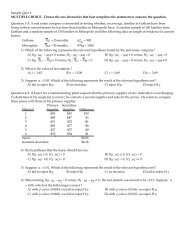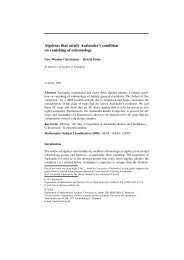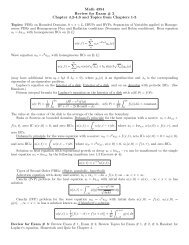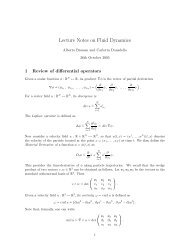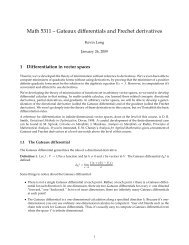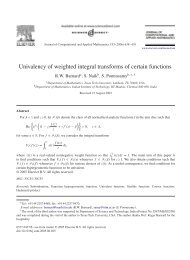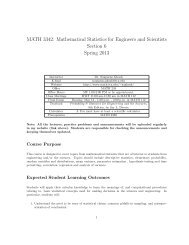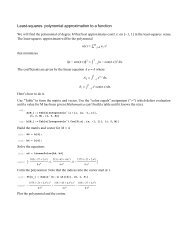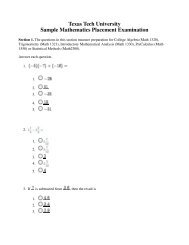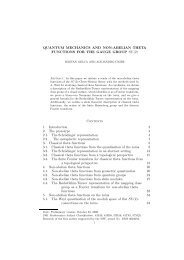A Variable Step-Size Selection Method for Implicit Integration ...
A Variable Step-Size Selection Method for Implicit Integration ...
A Variable Step-Size Selection Method for Implicit Integration ...
Create successful ePaper yourself
Turn your PDF publications into a flip-book with our unique Google optimized e-Paper software.
A. The Lotka-Volterra Model<br />
For this example we consider the Lotka-Volterra model of<br />
a simple predator-prey system from mathematical biology.<br />
This particular example is taken from Hairer, Lubich, and<br />
Wanner [4]. Consider the following system:<br />
[ ] [ ]<br />
u(v − 2)<br />
=<br />
= f(u, v); t ∈ [0, 50]. (9)<br />
˙u˙v v(1 − u)<br />
In (9), u(t) denotes the number of predators present at time<br />
t, v(t) represents the number of prey present at time t, and<br />
the constants one and two have been chosen arbitrarily. This<br />
system was integrated numerically using the implicit midpoint<br />
rule. Since the system is non-linear and the Lipschitz<br />
constant of the system as a whole is unknown, we will use<br />
the method described in Section III-B.<br />
This procedure was compared to a fixed step-size integration<br />
method with random step-sizes chosen. Two measures<br />
were chosen <strong>for</strong> comparison. The first measure, T , was total<br />
cpu time (in seconds) <strong>for</strong> 1000 runs with random initial<br />
data uni<strong>for</strong>mly distributed on [0.1, 10]. The second measure,<br />
E, was the maximum absolute variation of the numerical<br />
method from I(u, v) = ln u − u + 2 ln v − v, an invariant<br />
quantity <strong>for</strong> this system. The initial data <strong>for</strong> the system in<br />
this case was chosen to be [u(0) v(0)] T = [2 6] T .<br />
We found that <strong>for</strong> simple systems such as (9), the numerical<br />
computational overhead in computing the step-size<br />
in the optimal h method renders the method less useful<br />
than a simple fixed step-size method. After trying various<br />
fixed step-sizes, it was determined that <strong>for</strong> 1000 runs with<br />
random initial data, h = 0.125 was the fastest fixed stepsize<br />
attempted that permitted convergence. For h = 0.125,<br />
T = 118.3 and E = 0.064. For the optimal h method,<br />
various values <strong>for</strong> λ were tried until a comparable value <strong>for</strong><br />
E was found. For instance, <strong>for</strong> λ = 2 we get E = 0.143; <strong>for</strong><br />
λ = 3 we get E = 0.068; and <strong>for</strong> λ = 4 we get E = 0.037.<br />
Since λ = 3 yielded a comparable value of E, λ = 3 was<br />
chosen <strong>for</strong> 1000 runs with random initial data and it was<br />
found that T = 195.6.<br />
Different results arise when we try more challenging problems.<br />
Consider this variation to the Lotka-Volterra problem:<br />
[ ] [ ]<br />
u<br />
= ˙u˙v<br />
2 v(v − 2)<br />
v 2 = f(u, v); t ∈ [0, 50]. (10)<br />
u(1 − u)<br />
This system has has the same invariant as (9), but is very<br />
sensitive to random initial data. For this reason the initial<br />
data is fixed at [u(0) v(0)] T = [2 3] T <strong>for</strong> the computation<br />
of both T and E.<br />
Two methods were chosen to solve <strong>for</strong> the stage value y 1<br />
which is defined implicitly by (2). The first method is the<br />
algorithm of Section II, which is simply a Picard iteration.<br />
Secondly, we used Newton’s method to compute y 1 .<br />
The results from this example are given in Table IV-A.1<br />
and Table IV-A.2. In the tables, (P) stands <strong>for</strong> Picard and (N)<br />
stands <strong>for</strong> Newton, referring to the method used to compute<br />
the stage-values. To compare the fixed step-size method to<br />
the variable step-size method, we must locate times that are<br />
comparable from the tables and then compare the equivalent<br />
error. For example, we first notice that <strong>for</strong> the fixed step-size<br />
h = 0.1 in Table IV-A.1, the method took 160.7 seconds<br />
to solve the problem using a Picard iteration to solve <strong>for</strong><br />
y 1 . The error involved <strong>for</strong> this step-size was 0.094. Now we<br />
look in Table IV-A.2 and find that when λ = 2, the problem<br />
was solved in 168.4 seconds, which is about eight seconds<br />
longer than <strong>for</strong> h = 0.1. However, we notice that the error<br />
has been reduced to 0.004, which is about 4% of the error<br />
from when h = 0.1. We can locate other instances similar to<br />
this from the two tables. For the fixed step-size h = 0.08, the<br />
problem is solved in 234.4 seconds using Newton’s method<br />
to find y 1 , yielding an error of 0.069. We compare this to<br />
λ = 2 which was solved in 229.9 seconds with an error of<br />
0.004. In addition, <strong>for</strong> the fixed step-size h = 0.125 using<br />
Newton’s method to solve <strong>for</strong> y 1 , the problem is solved in<br />
155.6 seconds with an error of 0.084. We compare this to<br />
λ = 1 in which the problem is solved in 151.6 seconds with<br />
an error of 0.025.<br />
As one can see from the example above, inherent with<br />
this variable step-size selection method is the choice of the<br />
parameter λ. We will use the system given by equation (10)<br />
to explain how one should choose an appropriate value of λ<br />
when integrating a system that evolves over a long period of<br />
time. Suppose we are interested in integrating the system<br />
described by (10) over the interval [0, 500] or [0, 1000].<br />
First, we choose a much smaller value <strong>for</strong> the final time<br />
of integration; in this example that value is T = 50. We<br />
then integrate the system over the interval [0, 50] with a<br />
fixed step-size and at the same time with various values<br />
of λ. Essentially, we analyze how λ affects this system in<br />
particular, just as we did in the above example. After we have<br />
integrated the system over the much smaller time interval,<br />
we choose the value of λ that works best <strong>for</strong> this system<br />
to integrate the system over the entire time interval. This<br />
process should be done <strong>for</strong> any system where the length of<br />
the interval over which the integration must be per<strong>for</strong>med is<br />
quite large when compared to the evolution of the dynamics<br />
of the system.<br />
All computations were done in MATLAB R version<br />
6.1.0.450 Release 12.1 running in Microsoft Windows<br />
XP Professional version 5.1.2600 with an AuthenticAMD<br />
processor running at 1544 Mhz.<br />
TABLE IV-A.1<br />
FIXED STEP-SIZE<br />
h → 0.05 0.08 0.1 0.125<br />
T (P) 240.0 181.1 160.7 159.6<br />
E × 10 −2 (P) 3.1 6.9 9.4 8.4<br />
T (N) 354.4 234.4 187.7 155.6<br />
E × 10 −2 (N) 3.1 6.9 9.4 8.4<br />
B. The Kepler Problem<br />
This example, taken from Hairer, Lubich, and Wanner [4],<br />
is the well known two-body problem describing planetary<br />
motion. Consider the equations<br />
¨q i = −<br />
q i<br />
(q1 2 + , i = 1, 2 (11)<br />
q2 2 )3/2


